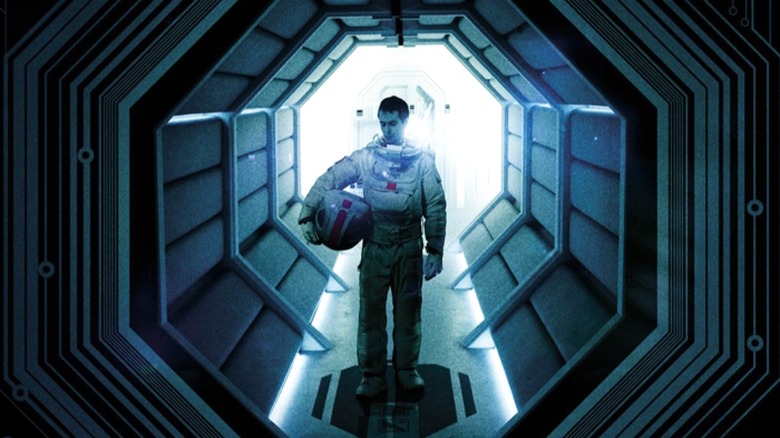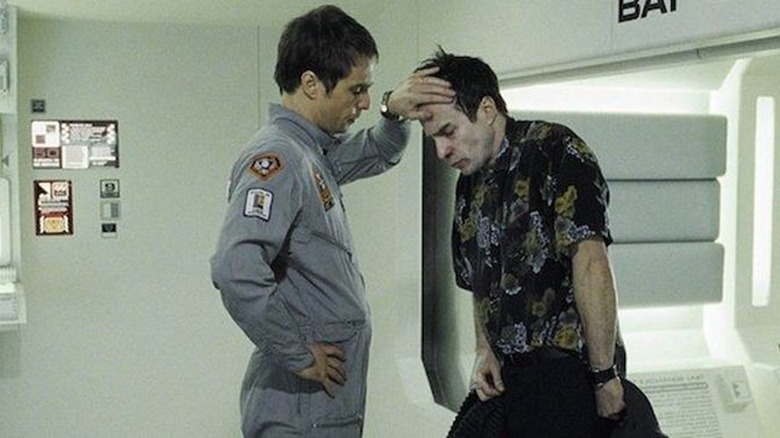How Moon Pulled Off Having Two Sam Rockwell Clones In One Shot
Spoilers for "Moon" follow.
Most post-apocalyptic science fiction tales focus on ravaged planets, the despair and hope in re-building human colonies, or the advent of new horrors in an already bleak universe. Duncan Jones' directorial debut, "Moon," zooms in on one man — rather, the various versions of a man long dead — while capturing the acute sense of isolation he feels during a three-year-long solitary stint on the far side of the moon. This man, Sam Bell (Sam Rockwell), is on the verge of breaking free from this lonely, monotonous routine, which is when a rover accident completely destabilizes his concept of self, including the emotion-fueled memories he thought were exclusively his.
When a newly activated Sam clone ventures outside and brings the unconscious Sam inside the facility, the two are immediately mired in conflict about who the "real" Sam is. After all, both men have the same memories about their wife, who was about to give birth when they had left for the mission, the only difference being that the Sam we meet first has memories of spending three years on Sarang Station. GERTY, an A.I. robot, tells them that they are both clones of the real Sam Bell, meant to forever repeat the three-year stint on a loop while being replaced by clones in the case of a mishap.
Most of the scenes where the two Sam clones are seen interacting feature them together in a shot, which was pretty tricky to pull off at the time, as CGI manipulation was not as common as it is today. Jones also wanted to evoke a sense of authenticity for audiences, so these scenes were filmed as practically as possible. How did Jones and Rockwell pull this off?
Two Sam clones have an existential crisis in Moon
In an interview with GQ, Rockwell explained that the scenes with the more "dominant" clone, who was more assertive in the scene, would be shot first, and followed up by the reactions of the other Sam. As Rockwell could not visually react to the actions of the first character, he relied on sound cues alone to streamline the other character accordingly:
"You get both clones in the same shot, the same frame. You'd be looking at a tennis ball, and we would shoot, usually, the dominant, the clone driving the scene first. We watched 'Dead Ringers' with Jeremy Irons. A lot of it depended on sound, too, 'cause on the day, you can't see what's happening. Sound guy put it on iPod, and I watched the previous day as I was getting hair and makeup for the other clone. So if the clone's coming towards me, and I have an earwig, and I hear the paddle drop, and then I know to retract if he's coming towards me. So it's very technical."
David Cronenberg's "Dead Ringers" features twins in the same shot throughout, with Jeremy Irons playing the dual role of identical twin gynecologists. Cronenberg's framing of the twins interacting (often in horrifically Cronenberg-ian ways) in a single shot looks and feels seamless, which explains why Rockwell and crew turned to the film to glean inspiration for their clone situation. Moreover, Jones, who spoke to The Guardian about the technicalities of filming Rockwell's dual performance, explained the fight scene between the clones was pulled off with the help of a stuntperson who wore a green stocking on his head, edited digitally in post.
In the end, Rockwell's compelling dual performance elevates "Moon" technical triumphs, which only feel more impressive with time.

